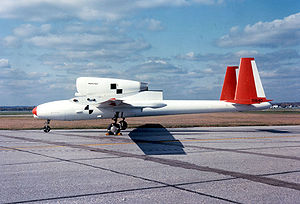Boeing YQM-94
| YQM-94 B-Gull Compass Cope B |
|
|---|---|
 |
|
| Boeing YQM-94A Compass Cope B at the National Museum of the United States Air Force. | |
| Role | Unmanned Aerial Vehicle (UAV) |
| Manufacturer | Boeing |
| First flight | 28 July 1973 |
| Status | Canceled |
| Primary user | United States Air Force |
The Boeing YQM-94 B-Gull (also called Compass Cope B) was a developmental aerial reconnaissance drone developed by Boeing. It could take off and land from a runway like a manned aircraft, and operate at high altitudes for up to 24 hours to perform aerial surveillance, communications relay, or atmospheric sampling.
Compass Cope was a program initiated by the United States Air Force (USAF) in 1971 to develop an upgraded reconnaissance drone that could take off and land from a runway like a manned aircraft, and operate at high altitudes for up to 24 hours to perform surveillance, communications relay, or atmospheric sampling. Two aircraft, the Boeing YQM-94 Compass Cope B, and the Ryan Aeronautical YQM-98A Compass Cope R participated in the program.
Boeing was originally selected as a sole source for the Compass Cope program, with the USAF awarding the company a contract for two YQM-94A (later YGQM-94A) demonstrator vehicles in 1971. However, Ryan then pitched an alternative, and the next year the USAF awarded Ryan a contract for two YQM-98A (later YGQM-98A) demonstrators as well.
The Boeing YQM-94A is a cantilever shoulder-wing monoplane, basically a jet-powered sailplane, with long straight wings, a twin fin tail, retractable tricycle landing gear, and a turbojet housed in a pod on its back. The engine was a General Electric YJ97-GE-100 providing 5,270 lb (2,390 kg) thrust. The YQM-94A was constructed using aluminium and fiberglass. The lower half of the circular-section fuselage was glass-fibre honeycomb, the same material used for radomes. The wings of the YQM-94A were constructed of aluminium-skinned honeycomb with a fiberglass core which insulated the fuel tanks from the cold encountered at the altitudes it was flown.
...
Wikipedia
